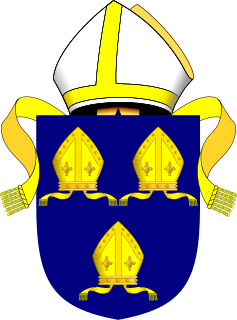Related Research Articles
Simon de Langham was an English clergyman who was Archbishop of Canterbury and a cardinal.
William de Corbeil or William of Corbeil was a medieval Archbishop of Canterbury. Very little is known of William's early life or his family, except that he was born at Corbeil, south of Paris, and that he had two brothers. Educated as a theologian, he taught briefly before serving the bishops of Durham and London as a clerk and subsequently becoming an Augustinian canon. William was elected to the See of Canterbury as a compromise candidate in 1123, the first canon to become an English archbishop. He succeeded Ralph d'Escures who had employed him as a chaplain.
Ralph d'Escures was a medieval abbot of Séez, bishop of Rochester and then archbishop of Canterbury. He studied at the school at the Abbey of Bec. In 1079 he entered the abbey of St Martin at Séez, and became abbot there in 1091. He was a friend of both Archbishop Anselm of Canterbury and Bishop Gundulf of Rochester, whose see, or bishopric, he took over on Gundulf's death.

Walter de Gray or Walter de Grey was an English prelate and statesman who was Archbishop of York from 1215 to 1255. He was Lord Chancellor under King John.

William Giffard, was the Lord Chancellor of England of William II and Henry I, from 1093 to 1101, and Bishop of Winchester (1100–1129).

Godfrey Giffard was Chancellor of the Exchequer of England, Lord Chancellor of England and Bishop of Worcester.

The Bishop of Norwich is the ordinary of the Church of England Diocese of Norwich in the Province of Canterbury. The diocese covers most of the county of Norfolk and part of Suffolk. The Bishop of Norwich is Graham Usher.
Reginald fitz Jocelin was a medieval Bishop of Bath and an Archbishop of Canterbury-elect in England. A member of an Anglo-Norman noble family, he was the son of a bishop, and was educated in Italy. He was a household clerk for Thomas Becket, but by 1167 he was serving King Henry II of England. He was also a favourite of King Louis VII of France, who had him appointed abbot of the Abbey of Corbeil. After Reginald angered Becket while attempting to help negotiate a settlement between Becket and the king, Becket called him "that offspring of fornication, that enemy to the peace of the Church, that traitor." When he was elected as a bishop, the election was challenged by King Henry's eldest son, Henry the Young King, and Reginald was forced to go to Rome to be confirmed by Pope Alexander III. He attended the Third Lateran Council in 1179, and spent much of his time administering his diocese. He was elected Archbishop of Canterbury in 1191, but died before he could be installed.
John of Thoresby was an English clergyman and politician, who was Bishop of St David's, then Bishop of Worcester and finally Archbishop of York. He was Lord Chancellor of England under King Edward III starting from 1349.

The Archbishop of York is a senior bishop in the Church of England, second only to the archbishop of Canterbury. The archbishop is the diocesan bishop of the Diocese of York and the metropolitan bishop of the Province of York, which covers the northern regions of England as well as the Isle of Man. The archbishop of York is an ex officio member of the House of Lords and is styled Primate of England; the archbishop of Canterbury is the "Primate of All England".
Herbert Poore or Poor (died 1217) was a medieval English clergyman who held the post of Bishop of Salisbury during the reigns of Richard I and John.

The Bishop of Ely is the ordinary of the Church of England Diocese of Ely in the Province of Canterbury. The diocese roughly covers the county of Cambridgeshire, together with a section of north-west Norfolk and has its episcopal see in the City of Ely, Cambridgeshire, where the seat is located at the Cathedral Church of the Holy Trinity. The current bishop is Stephen Conway, who signs +Stephen Elien:. The diocesan bishops resided at the Bishop's Palace, Ely until 1941; they now reside in Bishop's House, the former cathedral deanery. Conway became Bishop of Ely in 2010, translated from the Diocese of Salisbury where he was Bishop suffragan of Ramsbury.
Thomas Cobham was an English churchman, who was Archbishop-elect of Canterbury in 1313 and later Bishop of Worcester from 1317 to 1327.
Simon Langton was an English medieval clergyman who served as Archdeacon of Canterbury from 1227 until his death in 1248. He had previously been Archbishop-elect of York, but the election was quashed by Pope Innocent III.
Godfrey was a medieval Bishop of Bath.
Seffrid I, sometimes known as Seffrid Pelochin, was a medieval Bishop of Chichester.
Simon of Wells was a medieval Bishop of Chichester.
William Middleton was a medieval Bishop of Norwich.

John was a medieval Bishop of Rochester.
Theulf was a medieval Bishop of Worcester.
References
- Bethell, D. L. (1969). "English Black Monks and Episcopal Elections in the 1120s". The English Historical Review . 84 (333): 673–694. doi:10.1093/ehr/LXXXIV.CCCXXXIII.673.
- British History Online Bishops of Worcester accessed on 3 November 2007
- Fryde, E. B.; Greenway, D. E.; Porter, S.; Roy, I. (1996). Handbook of British Chronology (Third revised ed.). Cambridge: Cambridge University Press. ISBN 0-521-56350-X.
| Catholic Church titles | ||
|---|---|---|
| Preceded by Theulf | Bishop of Worcester 1125–1150 | Succeeded by John de Pageham |
| | This article about an English bishop or archbishop is a stub. You can help Wikipedia by expanding it. |